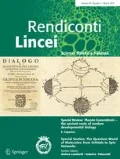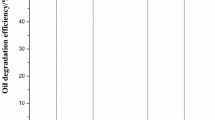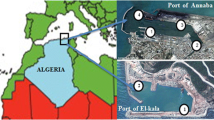Abstract
The temperature is one of the most important factors determining the success of bioremediation processes in marine environment. This study focused on the isolation and characterization of marine hydrocarbons-degrading bacteria from a cold region. Seawater samples were collected in the Ny-Ålesund Harbor and in the proximity of Kronebreen glacier (Kongsfjorden, Svalbard), and immediately enriched with nutrients and hydrocarbons as sole source of carbon. Samples were maintained at 4 °C for 90 days. Most probable number analyses showed a high number of hydrocarbons degraders from the samples collected in the harbor, while we were not able to detect hydrocarbon degraders in samples collected in the sea-ice region. The isolation was carried out at 4 and 15 °C, and a list of 38 strains was obtained in pure culture using both oil and polycyclic aromatic hydrocarbons as substrates. The selection inferred by the two different substrates was evident as oil favorites the growth of strains belonging to the γ-proteobacteria: Pseudoalteromonas, Marinobacter, Oleispira, and Alcanivorax genera while naphthalene and phenanthrene selected mostly α-proteobacteria: Sphingopyxis, Rhodobacter, and Hyphomonas genera. The isolated have been further selected for the formulation of a microbial consortium to test their potential to degrade both oil and polycyclic aromatic hydrocarbons at low temperature. Results demonstrated that the consortium was very active at 15 °C at which the almost 90 % of TPH were degraded; at 4 °C we were able to detect almost 80 % of degradation. Moreover, parallel single culture of each strain was not as efficient as in consortium.


Similar content being viewed by others
References
American Public Health Association (APHA) (1992) Standard methods for the examination of water and waste water, 18th edn. American Public Health Association, Washington, DC
Angelim AL, Costa SP, Farias BCS, Aquino LF, Melo VMM (2013) An innovative bioremediation strategy using a bacterial consortium entrapped in chitosan beads. J Environ Manag 127:10–17
Atlas RM (1981) Microbial degradation of petroleum hydrocarbons: an environmental perspective. Microbiol Rev 45(1):180–209
Atlas RM (1985) Effects of hydrocarbons on microorganisms and petroleum biodegradation in arctic ecosystems. In: Engelhardt FR(ed) Petroleum Effects in the Arctic Environment Elsevier, New York, pp 63–99
Atlas RM (1991) Microbial hydrocarbon degradation—bioremediation of oil spills. J Chem Technol Biotechnol 52(2):149–156
Atlas RM, Bartha R (1992) Hydrocarbon biodegradation and oil spill bioremediation. Adv Microb Ecol 12:287–338
Atlas R, Bragg J (2009) Bioremediation of marine oil spills: when and when not—the Exxon Valdez experience. Microbiol Technol 2:213–221
Boehm PD, Page DS, Brown JS, Neff JM, Bragg JR, Atlas RM (2008) Distribution and weathering of crude oil residues on shorelines 18 years after the Exxon Valdez spill. Environ Sci Technol 42:9210–9216
Bowman JS (2015) The relationship between sea ice bacterial community structure and biogeochemistry: a synthesis of current knowledge and known unknowns. Elementa Sci Anthropocene 3(1):000072. doi:10.12952/journal.elementa.000072
Brown EJ, Braddock JF (1990) Sheen screen, a miniaturized most-probable-number method for enumeration of oil-degrading microorganisms. Appl Environ Microbiol 56:3895–3896
Bushnell LD, Haas HF (1941) The utilization of certain hydrocarbons by microorganisms. J Bacteriol 41(5):653
Cappello S, Russo D, Santisi S, Calogero R, Gertler C, Crisafi F et al (2012) Presence of hydrocarbon-degrading bacteria in the gills of mussel Mytilus galloprovincialis in a contaminated environment: a mesoscale simulation study. Chem Ecol 28(3):239–252
Comeau AM, Li WKW, Tremblay J-É, Carmack EC, Lovejoy C (2011) Arctic Ocean microbial community structure before and after the 2007 record sea ice minimum. PLoS One 6(11):e27492
Crisafi F, Russo D, Genovese M, Catalfamo M, Smedile F, Giuliano L, Denaro R (2016) Bioremediation technologies for polluted seawater sampled after an oil-spill in Taranto Gulf (Italy): a comparison of biostimulation, bioaugmentation and use of a washing agent in microcosm studies. Mar Pollut Bull. doi:10.1016/j.marpolbul.2016.03.017
Denaro R, Mazzola S, Yakimov MM, Giuliano L (2013) RITMARE Italian research and industry for the sea. In: Mees J et al. (eds) Marine biotechnology in the European research area: challenges and opportunities for Europe. Final CSA marine biotech conference, vol 64. Royal Flemish Academy of Belgium for Science and the Arts, Brussels, p 43 (VLIZ Special Publication)
Deppe U, Richnow HH, Michaelis W, Antranikian G (2005) Degradation of crude oil by an arctic microbial consortium. Extremophiles 9(6):461–470
Dong C, Bai X, Sheng H, Jiao L, Zhou H, Shao Z (2015) Distribution of PAHs and the PAH-degrading bacteria in the deep-sea sediments of the high-latitude Arctic Ocean. Biogeosciences 12(7):2163–2177
Dyksterhouse SE, Gray JP, Herwig RP, Lara JC, Staley JT (1995) Cycloclasticus pugetii gen. nov., sp. nov., an aromatic hydrocarbon-degrading bacterium from marine sediments. Int J Syst Bacteriol 45:116–123. doi:10.1099/00207713-45-1-116
Gerdes B, Brinkmeyer R, Dieckmann G, Helmke E (2005) Influence of crude oil on changes of bacterial communities in Arctic sea-ice. FEMS Microbiol Ecol 53(1):129–139
Hop H, Pearson T, Nøst Hegseth E, Kovacs KM, Wiencke C, Kwasniewski S et al (2002) The marine ecosystem of Kongsfjorden, Svalbard. Polar Res 21(1):167–208. doi:10.1111/j.1751-8369.2002.tb00073.x
Jørgensen LL, Archambault P, Armstrong C, Dolgov A, Edinger E, Gaston T, Hildebrand J, Piepenburg D, Smith W, von Quillfeldt C, Vecchione M, Rice J (2016) Arctic Ocean. In: First global integrated marine assessment, Arctic oceans and law of the sea, United Nations, vol 36G, Arctic ocean, New York, pp 1–47
Juàrez Tomàs MS, Bru de Labanda E, de Ruiz Holgado AP, Nader-Macías ME (2002) Estimation of vaginal probiotic lactobacilli growth parameters with the application of the Gompertz model. Can J Microbiol 48:82–92
Lane DJ (1991) 16/23S rRNA sequencing. In: Stackebrandt E, Goodfellow M (eds) Nucleic acid techniques in bacterial systematics, John Wiley, New York, NY, pp 115–175
Maccario L, Vogel TM, Larose C (2014) Potential drivers of microbial community structure and function in Arctic spring snow. Front Microbiol 5:413
Maidak BL, Olsen GJ, Larsen N et al (1997) The RDP (ribosomal database project). Nucleic Acids Res 25(109):1–11
Malavenda R, Rizzo C, Michaud L, Gerçe B, Bruni V, Syldatk C, Hausmann R, Giudice AL (2015) Biosurfactant production by Arctic and Antarctic bacteria growing on hydrocarbons. Polar Biol 10(38):1565–1574
Margesin RF, Schinner F, Marx J-C, Gerday C (2008) Psychrophiles from biodiversity to biotechnology. Springer, Berlin
Marghesin R, Schinner F (2001) Bioremediation (natural attenuation and biostimulation) of diesel-oil-contaminated soil in an alpine glacier skiing area. Appl Environ Microbiol 67(7):3127–3133
Michaud L, Giudice AL, Saitta M, De Domenico M, Bruni V (2004) The biodegradation efficiency on diesel oil by two psychrotrophic Antarctic marine bacteria during a two-month-long experiment. Mar Pollut Bull 49(5):405–409
Newbury T (2001) The natural history of an arctic oil field: development and the biota. In: Truett JC, Johnson SR (eds) ARCTIC, 54(4)
Paniagua-Michel J, Rosales A (2015) Marine bioremediation—a sustainable biotechnology of petroleum hydrocarbons biodegradation in coastal and marine environments. J Bioremediat Biodegrad 6:273
Poland JS, Riddle MJ, Zeeb BA (2003) Contaminants in the Arctic and the Antarctic: a comparison of sources, impacts, and remediation options. Polar Rec 39:369–383
Porter KG, Feig YS (1980) The use of DAPI for identifying and counting aquatic microflora. Limnol Oceanogr 25:943–948
Pritchard PH, Costa CF (1991) EPA’s Alaska oil spill bioremediation project. Environ Sci Technol 25:372–379
Røberg S, Østerhus JI, Landfald B (2011) Dynamics of bacterial community exposed to hydrocarbons and oleophilic fertilizer in high-Arctic intertidal beach. Polar Biol 34:1455–1465
Rocchetti L, Beolchini F, Ciani M, Dell’Anno A (2011) Improvement of bioremediation performance for the degradation of petroleum hydrocarbons in contaminated sediments. Appl Environ Soil Sci. doi:10.1155/2011/319657
Short JW, Maselko JM, Lindeberg MR, Harris PM, Rice SD (2006) Vertical distribution and probability of encountering intertidal Exxon Valdez oil on shorelines of three embayments within Prince William Sound, Alaska. Environ Sci Technol 40:3723–3729
Troussellier M, Got P, Mboup M, Corbin D, Giuliano L et al (2005) Daily bacterioplankton dynamics in a sub-Saharan estuary (Senegal River, West Africa): a mesocosm study. Aquat Microb Ecol 40(1):13–24
Venosa AD, Suidan MT, Wrenn BA, Strohmeier KL, Haines JR, Eberhart BL, King D, Holder E (1996) Bioremediation of an experimental oil spill on the shoreline of Delaware Bay. Environ Sci Technol 30:1764–1775
Winnepenninckx B, Backeljau T, De Wachter R (1993) Extraction of high molecular weight DNA from molluscs. Trends Genet 9:407
Yakimov MM, Golyshin PN, Lang S, Moore ER, Abraham WR, Lünsdorf H, Timmis KN (1998) Alcanivorax borkumensis gen. nov., sp. nov., a new, hydrocarbon-degrading and surfactant-producing marine bacterium. Int J Syst Evol Microbiol 48(2):339–348
Yakimov MM, Giuliano L, Gentile G, Crisafi E, Chernikova TN, Abraham WR, Lünsdorf H, Timmis KN, Golyshin PN (2003) Oleispira antarctica gen. nov., sp. nov., a new hydrocarbonoclastic marine bacterium, isolated from an Antarctic coastal seawater. Int J Syst Evolut Microbiol 53:779–785
Yakimov MM, Cappello S, Crisafi E, Tursi A, Corselli C, Scarfı S, Giuliano L (2006) Phylogenetic survey of metabolically active microbial communities associated with the deep-sea coral Lophelia pertusa from the Apulian Plateau, Central Mediterranean Sea. Deep Sea Res Part I 53:62–75
Yakimov MM, Timmis KN, Golyshin PN (2007) Obligate marine hydrocarbonoclastic bacteria. Curr Opin Biotechnol 18:257–266
Zwietering MH, Jongenburger I, Van’t Rombouts FM, Riet K (1990) Modeling of the bacterial growth curve. Appl Environ Microbiol 56:1875–1881
Acknowledgments
This work was funded by the European Community Project KILL-SPILL (FP7-KBBE-2012.3.5-01-4 Project 312139 “Integrated Biotechnological Solutions for Combating Marine Oil Spills”). Moreover, we want to thank Maurizio Catalfamo for the technical assistance during hydrocarbons analyses.
Author information
Authors and Affiliations
Corresponding author
Additional information
This peer-reviewed article is a result of the multi and interdisciplinary research activities based at the Arctic station “Dirigibile Italia”, coordinated by the “Dipartimento Scienze del Sistema Terra e Tecnologie per l’Ambiente” of the National Research Council of Italy.
Rights and permissions
About this article
Cite this article
Crisafi, F., Giuliano, L., Yakimov, M.M. et al. Isolation and degradation potential of a cold-adapted oil/PAH-degrading marine bacterial consortium from Kongsfjorden (Arctic region). Rend. Fis. Acc. Lincei 27 (Suppl 1), 261–270 (2016). https://doi.org/10.1007/s12210-016-0550-6
Received:
Accepted:
Published:
Issue Date:
DOI: https://doi.org/10.1007/s12210-016-0550-6




